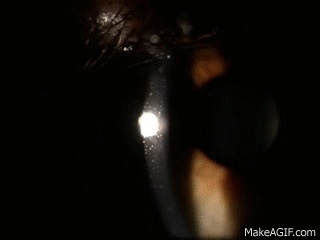
Contact lens wearers: Can eye makeup cloud your vision?
Vision scientist says contact lenses can trap cosmetics in your eye and disrupt your vision

Vision scientist says contact lenses can trap cosmetics in your eye and disrupt your vision
By Natalee Blagden Faculty of Science, Professional SchoolsWhile fashion comes and goes your eyes are forever so one Waterloo researcher is cautioning people who wear contact lenses - but love the drama of heavy eye makeup - to consider wearing daily disposable lenses.
Alison Ng, a postdoctoral fellow at the University of Waterloo’s Centre for Contact Lens Research (CCLR), studied how eyeliner applied to the “waterline,” the inner part of the eyelash line, moves onto the tear film - the thin, wet layer that protects the eye.
In her research, Ng captured more than 200 frames of video at timed intervals of her subject’s eyes. She and her research team then used specialized software to count every tiny particle of glitter that appeared on the surface of the eye and the results were clear -- when we apply makeup along the waterline more eyeliner moves into the tear film.

This video shows a close-up of the eyeball using a video slit lamp, a common instrument used in regular eye exams. An intense, narrow beam of light shows how glitter eyeliner applied to the upper and lower eyelids is now on the tear film, the thin wet layer that protects the eyeball.
While that’s not good news for anyone, Ng’s research showed that the makeup gets flushed away by your tears within a couple of hours. But people who wear contact lenses run bigger risks because the makeup can get trapped by the lenses and affect your vision.
Contact lenses add a physical barrier and lenses worn for multiple days are especially problematic because they continually re-introduce and collect unwanted debris, cautions Ng. “This can create cloudiness in contact lenses and disrupt vision,” she says. “For anyone who wears heavy makeup or enjoys regularly applying beauty products around the eye, I would recommend daily disposable lenses for optimal cleanliness and comfort.”
Anyone with dry eyes -- thanks to genetics, or environment, or staring at a screen all day -- may also be susceptible to more noticeable irritation, Ng says. Her study used healthy females without contact lenses as a baseline, but the connection to dry eyes and contacts is obvious. Makeup residue floating in the tear film is something optometrists see nearly every day, she says. What she wondered is: just much makeup is moving from where we want it to where we don’t?Ng conducted the research while completing her PhD at Cardiff University. The findings appear in the most recent issue of Eye and Contact Lens, the official peer-reviewed journal of the Contact Lens Association of Ophthalmologists.

Redness, itchiness, or irritation are all signs that it may be time to switch up your makeup routine to keep your eyes clear and healthy.
“You have to think about cosmetic use at all stages. Consider which products you choose, how you apply the products, and how you remove them at bedtime,” says Ng.
Prevent bacterial transfer by sharpening eye pencils thoroughly before each use. Twist-up products are tricky, but manageable, says Ng. She recommends that people who favour this style of eyeliner trim a small piece of eyeliner from the end of the product before every application.
When she’s not conducting research, Ng writes about cosmetics and eye health in Contact Lens Update, a reference tool that the Centre for Contact Lens Research (CCLR) provides for eye care clinicians. The CCLR team have produced a handy tip sheet for the public describing best practices to maintain eye health, and comfort.
Visit the CCLR recruitment page to sign up to participate in current or upcoming clinical trials.

Read more
Here are the people and events behind some of this year’s most compelling Waterloo stories

Read more
Meet five exceptional Waterloo graduate students crossing the convocation stage as Class of 2025 valedictorians

Read more
From co-op to startup: Waterloo students develop an AI platform that uses real-time data for wildfire prediction and early prevention
The University of Waterloo acknowledges that much of our work takes place on the traditional territory of the Neutral, Anishinaabeg, and Haudenosaunee peoples. Our main campus is situated on the Haldimand Tract, the land granted to the Six Nations that includes six miles on each side of the Grand River. Our active work toward reconciliation takes place across our campuses through research, learning, teaching, and community building, and is co-ordinated within the Office of Indigenous Relations.